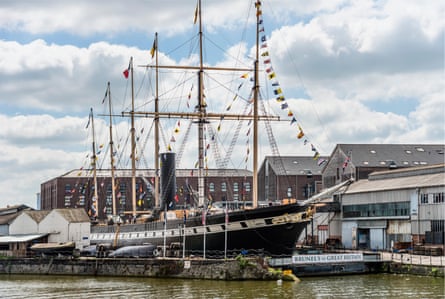In a nutshell
Isambard Kingdom Brunel’s SS Great Britain was called “the greatest experiment since the Creation” when it was launched in 1843. The first iron ship to cross the Atlantic, it travelled more than a million miles. Now restored and in dry dock, it is full of live actors and fun, interactive exhibits.
You start by walking under the impressive hull, and can see the gaily decorated masts above, as if it’s about to set sail. The museum tells the story of the ship from ocean liner to emigrant clipper, windjammer (cargo ship) and finally “grand old lady”. Visitors can steer by the stars, dress up as a emigrant family, and meet passengers from gold diggers to the first “All England” cricket team to tour Australia. Top-hatted Isambard Kingdom Brunel wanders around, cigar in hand, telling stories and answering questions.
After the museum, boarding the ship itself gives a glimpse of what it was like to make the 60-day journey from Liverpool to Australia in the 1900s, with cabins, galley, engine room, officers’ quarters (and loos) filled with sounds and smells. Up top, there are decks to be scrubbed and quoits to be played – or pay £10, put on a harness and climb the rigging.

Fun fact
On a typical journey, the ship carried 120 sheep, 5 lambs, 30 pigs, 2 bullocks, 1 cow, 500 fowls, 300 ducks, 60 geese, 30 turkeys and 5 rabbits to provide fresh meat and milk to passengers and crew.
Best thing about it
It’s cleverly arranged to entertain and inform all ages. We had great fun exploring the decks, trying to spot rats, and squeezing through the cramped steerage section, filled with the sounds of babies crying and passengers chatting, sneezing and snoring.
What about lunch?
The on-site Dockyard Café serves sandwiches (from £3.95) and jacket potatoes (from £5.95). Kids’ toasties are £3. A stroll away, Wapping Wharf is a new shipping container complex full of indie restaurants and bars: Root serves small dishes such as pumpkin risotto and cider rarebit from £2.50-£7.
Exit through the gift shop?
Yes, and it’s packed with maritime-themed toys, books and gifts, including captain’s hats (£5.99) and a chocolate engineers’ tool kit (£8.21).

Getting there
Bristol Temple Meads station is a 30-minute walk or short ferry or bus ride away. Ferries run from the station, Capricorn Quay, and the new harbour inlet. The Wessex Connect 506 bus operates from the train station. By car, follow the brown tourist signs for SS Great Britain.
Value for money?
Yes. You could easily spend several hours here and the ticket includes unlimited return visits for a year. Entry is £14 adult, £8 child over four. Family tickets available.
Opening hours
Daily 10am-4.30pm 1 November-25 March (last entry 3.30pm) spring and summer 10am-5.30pm (last entry 4.30pm). Closed 24-26 December.
What’s new
Being Brunel, a new museum and visitor experience opens next spring, focusing on the engineer’s life and achievements.
Verdict
9/10 great fun!

Comments (…)
Sign in or create your Guardian account to join the discussion